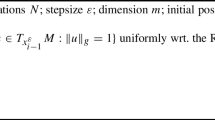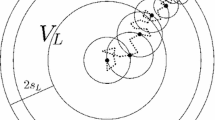Abstract
In this article, we introduce an algorithm that simulates efficiently the first exit time and position from a rectangle (or a parallelepiped) for a Brownian motion that starts at any point inside. This method provides an exact way to simulate the first exit time and position from any polygonal domain and then to solve some Dirichlet problems, whatever the dimension. This method can be used as a replacement or complement of the method of the random walk on spheres and can be easily adapted to deal with Neumann boundary conditions or Brownian motion with a constant drift.
Similar content being viewed by others
References
J. V. Beck, K. D. Cole, A. Haji-Sheikh, and B. Litkouhi, Heat conduction using Green's functions, Series in Computational and Physical Processes in Mechanics and Thermal Sciences, Hemisphere Publishing Corp.:London, 1992.
L. Breiman, Probability, Addison-Wesley, 1981.
F. Campillo and A. Lejay, “A Monte Carlo method without grid for a fractured porous domain model,” Monte Carlo Methods and Applications vol. 8(2) pp. 129–148, 2002.
J. M. DeLaurentis and L. A. Romero, “A Monte Carlo method for Poisson's equation,” Journal of Computational Physics vol. 90(1) pp. 123–140, 1990.
L. Devroye, Non-Uniform Random Variate Generation, Springer-Verlag, 1986.
M. S. P. Eastham, Theory of ordinary differential equations, Van Nostrand Reinhold Company, 1970.
N. Golyanda, “Convergence rate for spherical processes with shifted centres,” Monte Carlo Methods and Applications vol. 10(3–4), pp. 287–296, 2004. Conference proceeding of IV IMACS Seminar on Monte Carlo Methods.
C.-O. Hwang, M. Mascagni, and J. A. Given, “A Feynman-Kac path-integral implementation for Poisson's equation using an \(h\)-conditioned Green's function,” Mathematics and Computers in Simulation vol. 62(3–6) pp. 347–355, 2003. 3rd IMACS Seminar on Monte Carlo Methods-MCM 2001 (Salzburg).
V. Linetsky, “On the transition densities for reflected diffusions,” Advances in Applied Probability vol. 37(2) pp. 435–460, 2005.
S. Maire, Réduction de variance pour l'intégration numérique et pour le calcul critique en transport neutronique, PhD thesis, Université de Toulon et de Var (France), 2001.
G. N. Mil'shtejn and N. F. Rybkina, “An algorithm for random walks over small ellipsoids for solving the general Dirichlet problem,” Computational Mathematics and Mathematical Physics vol. 33(5) pp. 631–647, 1993.
G. N. Milstein and M. V. Tretyakov, “Simulation of a space-time bounded diffusion,” Annals of Applied Probability vol. 9(3) pp. 732–779, 1999.
M. E. Muller, “Some continuous Monte Carlo methods for the Dirichlet problem,” Annals of Mathematical Statistics vol. 27 pp. 569–589, 1956.
B. Nœtinger and T. Estébenet, “Up scaling of fractured media using continuous-time random walks methods,” Transport in Porous Media vol. 39(3) pp. 315–337, 2000.
W. H. Press, S. A Teukolsky, W. T. Vetterling, and B. P. Flannery, Numerical Recipes in C (2nd ed.), Cambridge University Press, 1992.
K. Sabelfeld, I. Shalimova, and A. I. Levykin, “Discrete random walk on large spherical grids generated by spherical means for PDEs,” Monte Carlo Methods and Applications vol. 10(3–4) pp. 559–574, 2004. Conference proceeding of IV IMACS Seminar on Monte Carlo Methods.
K. K. Sabelfeld and D. Talay, “Integral formulation of the boundary value problems and the method of random walk on spheres,” Monte Carlo Methods and Applications vol. 1(1) pp. 1–34, 1995.
N. A. Simonov and M. Mascagni, “Random walk algorithm for estimating effective properties of digitized porous media,” Monte Carlo Methods and Applications vol. 10(3–4) pp. 599–608, 2004. Conference proceeding of IV IMACS Seminar on Monte Carlo Methods.
S. Torquato and C. Kim, “Effective conductivity, dielectric constant, and diffusion coefficient of digitized composite media via first-passage-time equations,” Journal of Applied Physics vol. 85(3) pp. 1560–1571, 1999.
D. Veestraeten, “The conditional probability density function for a reflected Brownian motion,” Computational Economics vol. 24(2) pp. 185–207, 2005.
E. Zauderer, Partial differential equations of applied mathematics. Pure and Applied Mathematics, John Wiley & Sons Inc.: New York, 1983.
Author information
Authors and Affiliations
Corresponding author
Additional information
AMS 2000 Subject Classification
60C05, 65N
Rights and permissions
About this article
Cite this article
Deaconu, M., Lejay, A. A Random Walk on Rectangles Algorithm. Methodol Comput Appl Probab 8, 135–151 (2006). https://doi.org/10.1007/s11009-006-7292-3
Received:
Revised:
Accepted:
Published:
Issue Date:
DOI: https://doi.org/10.1007/s11009-006-7292-3




